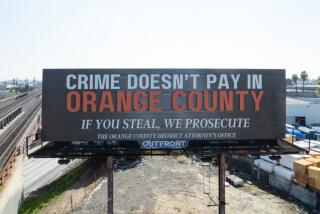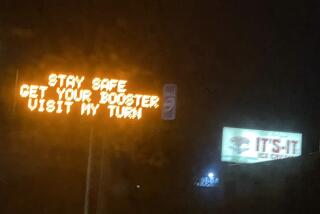RTD to Cut Out Use of Its Pushy ‘Cut-In’ Message
- Share via
At the beleaguered RTD, officials now have managed to create a controversy over how they apologize to the public.
In the face of complaints--and against a backdrop of highway violence and police admonishments to avoid conflicts on the roads--RTD managers are toning down a new, rather pushy public relations message tacked on the rear of about 120 buses.
“Sorry. If I don’t cut in front, I’ll fall behind. Thanks,” say the placards, each bearing the signature of a different bus driver.
“Some people didn’t like that (message),” said RTD spokesman John Hyde, citing more than a dozen complaints from the public, from drivers themselves and from union officials since the signs first appeared on buses July 6. A more polite message is in the works.
The intent of the placards, RTD officials say, was to find a catchy way to alert motorists to the problems that bus drivers face each day as they struggle to maintain schedules on congested streets.
“Nobody likes the bus cutting in front of them,” Hyde said. “So what do you do to try to keep the public in an understanding mode so it doesn’t get frustrated?”
What the RTD did was pay a Los Angeles advertising agency $1,200 to develop the “cut-in” message. The placards were produced by the RTD print shop at an additional cost of several hundred dollars.
“The intent was to be apologetic and gracious,” said Robert Vanderstok, senior vice president of the ad firm of Gumpertz, Bentley and Fried. “I recognize some people didn’t take it that way. . . . In hindsight that particular approach was one that had some misunderstandings with it.”
Earl Clark, general chairman of the bus drivers’ union, said he warned RTD officials that the ads would be troublesome. “I said it had a very negative message. . . . It would upset motorists more than soothe.”
Clark said he thought he had persuaded the district’s marketing department to rewrite the signs. The next thing he knew, Clark said, the placards were on buses and his drivers were calling to complain.
“One of the drivers was so upset he refused to take a bus out with the sign on the back,” Clark said. “He felt he would get a very hostile reaction from motorists. . . . He felt that even if he moved out in a safe manner, someone would take it as cutting them off.”
Bus drivers also complained that motorists are led to believe that the driver who signed the warning is the one behind the wheel, which in many instances is not the case, Clark said.
On Wednesday, no one was eager to claim credit for the controversial signs. Hyde initially told The Times that the cards were “the idea of our advertising agency.” But Vanderstok said his firm had proposed several ideas and RTD officials had chosen the message. RTD marketing director Tony Fortuno later acknowledged that the decision was made “collectively” by transit officials.
While the ads have had the opposite effect from what was intended, Vanderstok and Hyde said there has been no discussion of a refund from the ad agency. “There are no guarantees of any advertising agency to any client,” Vanderstok said.
For more than a year, the district has struggled with difficulties on a number of fronts, in each case attempting to counter with public relations efforts to improve its reputation. The troubles have ranged from driver-level problems of drug usage and absenteeism and a spate of accidents to mismanagement and loose spending by high RTD officials, leading to a legislative attempt that is under way now to dissolve the agency and create a new transit authority.
In a week or so, most of the offending signs are expected to be off the buses. At an additional cost of nearly $1,000, the RTD will retreat to a more deferential message that was used a few years ago and may be better suited for today’s tense times on the road.
“Pardon my back, and thanks for letting me in,” the new signs will say.
“That’s a heck of a lot better than the other one,” Clark said.
The reason officials did not simply resurrect the old ad in the first place, Fortuno said, was that “we wanted to start fresh looking at a problem.” When the new slogan met resistance, he said, the district wanted a replacement that it could turn to quickly, without a drawn out approval process.
More to Read
Sign up for Essential California
The most important California stories and recommendations in your inbox every morning.
You may occasionally receive promotional content from the Los Angeles Times.










